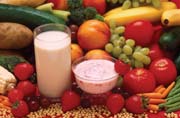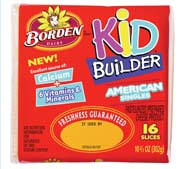Indeed, most consumers are in full agreement with the farmer regarding milk's nutritional status. In fact, milk has a special place in most consumers' diets. Whether they pour it on cereal, dunk cookies in it, or enjoy it as a base for a shot of espresso, consumers associate milk with specific foods and meal occasions.
The problem today's dairy industry faces is that consumers have come to expect more and more from everything in their life. From 100-plus television stations via satellite to an extra six-inches of leg-room in coach on certain airlines, consumers want more out of the basics. And, with widespread use of nutritional bars and beverages, Americans have also come to expect more nutrients and healthful ingredients from the foods and beverages consumed on a daily basis.
The dairy industry is poised to jump on board the functional foods bandwagon, as not only is milk inherently highly nutritious, it also was the first food to ever be fortified for purely supplemental reasons. (Vitamin D was added to milk in the early 1930s to help prevent the bone-debilitating disease rickets.) Opportunities exist to use milk in many products, from beverages to prepared entrees. Boosting the nutritional profile of milk helps dairies effectively compete in the now established category labeled functional foods.

Functional foods are official
On March 24, Chicago-based Institute of Food Technologists issued a scientific report entitled Functional Foods: Opportunities and Challenges. The very publishing of such a report confirms the existence of such a category of foods and beverages.Functional foods are defined as foods and food components that provide a health benefit beyond basic nutrition. This includes conventional foods; fortified, enriched or enhanced foods; and dietary supplements. Functional foods can enhance performance and deliver benefits for conditions such as coronary heart disease, osteoporosis and neural tube defects. The report notes that researchers have identified food components that may improve memory, reduce arthritis and provide other benefits heretofore limited to drugs. It states that future benefits might include foods for increased energy, mental alertness and better sleep.
Functional foods are at the threshold of unprecedented influence on public health and disease prevention. The report states that advances in science and food technology are growing so rapidly that the food industry and government must quicken their pace to ensure food's greatest benefits on public health. This means that all the powers of milk that the industry has been aware of for so long can now be more easily demonstrated and proven to the rest of the world.
The report advises that functional foods be brought to market in a new, seven-step scientific process (see sidebar). One part of the process introduces Generally Recognized As Efficacious, patterned after the USDA's successful Generally Recognized As Safe (GRAS) review. The report deems that economic incentives such as tax breaks, market exclusivity or a combination of both would serve as catalysts for increasing food company investment in functional food research. And the report urges that label claims on functional foods reflect scientific evidence, driving consumer understanding of dietary components for health.
Included in the report is a call for expanded research on traditional nutrients, other bioactive food components and the intersection of genomics and molecular nutrition. Excitingly, the dairy industry has been actively pursuing these areas for some time now.
Genomics is the study of whole genomes, or the complete DNA (deoxyribonucleic acid) sequence or genetic material of an individual or organism, and the arrangement and function of genes. Narrowing things down, nutrigenomics is the study of the interaction of dietary components with genes, describing how specific dietary components such as vitamins, minerals, fatty acids, phytochemicals or food metabolites affect the protein profile of an individual.
Why protein? Research indicates that many functional benefits are associated with protein formation. The assumed process suggests that the nutrients that comprise foods affect gene expression, which is the process through which the DNA comprising genes is converted to RNA (ribonucleic acid) and proteins are produced. The various proteins formed at discrete points in this process function as enzymes (essential compounds that aid biochemical reactions), hormones and other substances on which life depends.
The amount, form and even the frequency of nutrients consumed can affect protein manufacture, resulting in less protein being produced, less than optimal functional forms of proteins or no protein at all.
The relationship between the dairy proteins inherently present in milk are actively being investigated. Findings from the past decade were published in proceedings from a session at the May 7, 2003, American Oil Chemists' Society Annual Meeting. Entitled The Emerging Role of Dairy Proteins and Bioactive Peptides in Nutrition and Health. This report was published in a special supplement to the April 2004 issue of the Journal of Nutrition. (For reprints of this research review, call Dairy Management Inc.'s Technical Hotline at 800/248-8829.)
The proceedings include findings on how the protein component of milk represents a variety of bioactive amino acids and peptides that function as growth factors, anti-hypertensive agents, antimicrobial factors, food intake modifiers and immune regulatory factors. And, excitingly, new and improved fractionation methods now provide a means to isolate these healthful components in milk and incorporate them in new products, dairy- and non-dairy-based.
Researchers are using genomics as a tool to better understand the role of dairy proteins in human health. Challenges include advancing food products beyond the successes of taste, convenience, safety and the provision of essential nutrients, and to build the knowledge base necessary for developing foods that deliver documented health benefits.

Genomics help overcome challenges
The insight gained from genetic research provides opportunities to prevent disease and improve the quality of life through functional foods and tailored diets. Discoveries in genetics make it possible to understand the effects of nutrients in processes at the molecular level in the body and also the variable effects of dietary components on each individual."Functional foods should be integral components of public health programs to reduce the risk of specific diseases," according to Fergus Clydesdale, chair of the IFT Expert Panel and co-author of the report, and department head of food science at University of Massachusetts. "The functional foods currently available represent only a fraction of the potential opportunities for consumers to manage their health through diet. It is imperative to further research to validate full effectiveness and establish appropriate dietary levels."
Discoveries in genetics make it possible to understand the effects of nutrients in processes at the molecular level in the body and also the variable effects of dietary components on the individual. It is likely that very soon, consumers could tailor their diets to meet changing health goals and different requirements at different ages.
As stated, dairy industry researchers are showing that milk, an inherently nutritious food, is an ideal vehicle for delivering such other nutrients. The report identifies these nutrients as being traditional vitamins, minerals and essential fatty acids for which recommended intakes have been established. The definition also includes other components such as phytonutrients or bioactive substances present in foods for which a physical or physiological effect has been scientifically documented, or for which a substantial body of evidence exists for a plausible mechanism, but for which a recommended intake and function have not been definitively established.
Scientists are urged to identify and tailor ideal food vehicles and packaging to deliver functional nutrients to consumers. The vehicle must provide a stable environment for the functional nutrients, as well as maintain bioavailability. And, of course, the functional food must possess desirable sensory and organoleptic characteristics.
Milk and dairy foods are ideal vehicles for delivering functional ingredients, including functional ingredients isolated from milk itself. From adding bioactive proteins and probiotic bacteria to fiber and essential fatty acids, milk and dairy products are poised to be leaders in the functional foods movement.
Are you interested in reading the complete scientific report Functional Foods: Opportunities and Challenges? It is available online at www.ift.org/expertreport.
Sidebar: Seven Steps in Bringing Functional Foods to Market
1. Identify the relationship between the food component and the health benefit.2. Demonstrate efficacy and determine the intake level necessary to achieve the desired effect.
3. Demonstrate safety at efficacious levels.
4. Develop a suitable food vehicle for the bioactive component.
5. Demonstrate scientific sufficiency of the evidence for efficacy.
6. Communicate benefits to consumers.
7. Conduct in-market surveillance to confirm efficacy and safety.
Source: Institute of Food Technologists' report: Functional Foods: Opportunities and Challenges

Sidebar: Real Life Examples
Functional dairy foods are already quite plentiful in today's marketplace, both here and abroad. Take a quick glance at this month's New Product Review and you will find a frozen custard fortified with protein and a nonfat milk with beneficial bacteria.At press time, Dairy Farmers of America (DFA), Kansas City, Mo., was rolling out Borden® Kid Builder™ American Singles. Each individually wrapped process cheese slice is fortified to be rich in calcium, which is important for building strong bones, and is a good source of six essential vitamins and minerals (A, B6, C, D, E and zinc) that children need to grow up healthy.
Earlier this year, General Mills Inc., Minneapolis, introduced the first U.S. yogurt to contain cholesterol-lowering plant sterols. And, Johanna Foods Inc., Flemington, N.J., markets La Yogurt® Enriched, which is blended low-fat yogurt with extra calcium and vitamins A, C, D and E.
Overseas, the Netherlands-based dairy processing leader Campina debuted Valess, the first meat substitute based on dairy proteins. Valess is said to look and taste like meat, yet it is meat-free.
More of a healthful alternative to meat than a true functional food, Valess is unique. It is made by curdling low-fat milk and adding fiber. A blend of flavors and herbs gives the product a taste that can compete with meat. Valess is low in fat, only 4% to 9%, depending on variety, with the fat primarily being polyunsaturated fatty acids from sunflower oil. Valess is also low in calories and carbohydrates, yet packed full of highly nutritional dairy proteins.
The opportunities are endless in the area of functional food product development, and dairy is sure to be a leading carrier of good-for-you nutrients.